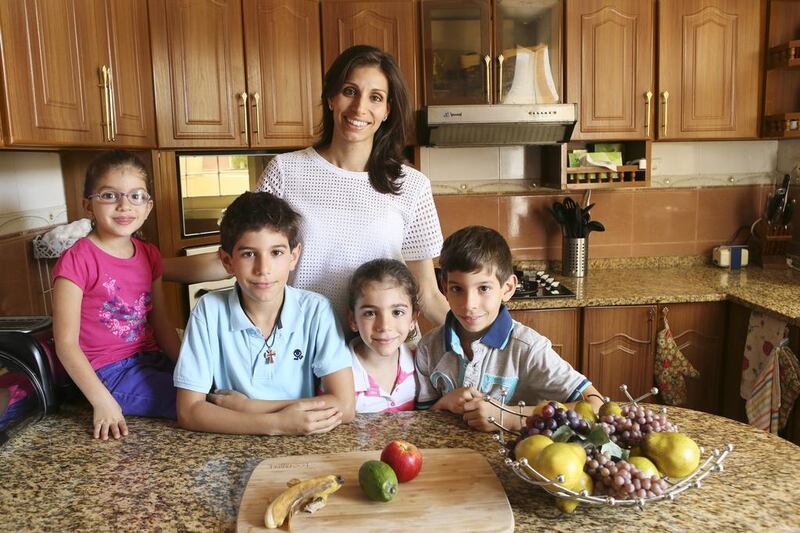If you feel like mealtime with the children is more of a battle of wills than a chance to connect with each other and build healthy-eating habits, you are not alone.
Whether you are dealing with toddlers or teenagers, enjoying a meal without having to fight through protests, negotiation and tears can be a challenge that isn’t always easy to tackle with tenacity – let’s face it, it sometimes requires a serious dose of humour.
Giving children the best possible start in life by teaching them to make smarter food choices can set them up for healthier lifestyles as adults, avoiding obesity and reducing the chances of diabetes and hypertension in the process.
Beyond educating children to eat better, providing a wide array of nutritious foods rich in vitamins, minerals and antioxidants is crucial for their physical and mental development.
Dr Hala Fikri Mohammed El Hagrasi, a consultant and head of paediatrics at Burjeel Hospital in Abu Dhabi, says nutritional deficiencies can not only delay bone growth and development, but also mental development, with the potential effects including a lower IQ, attention-deficit disorder and learning disabilities.
“It is important for children to have a varied diet because their bodies are still growing and developing,” she explains.
“Different foods contain different vitamins and minerals, which the body needs to grow and function properly. A deficiency in one nutrient can cause a chain reaction, causing a deficiency in another nutrient. For example, zinc and protein deficiencies can delay bone growth and development, which can result in long-term complications for the child’s growth.”
But how do you persuade a child who turns up his or her nose at healthy food such vegetables, fish, grains, pulses or fruit, without having a meal descend into a frustration-fuelled event?
“Educating your child about the benefits of certain foods may help them become more willing to try new foods,” says Bernadette Abraham, a nutritional therapy practitioner and wellness coach in Dubai, and a mother of four.
“For example, walnuts look like the brain, and are good for the brain. Celery is long and strong like bones and it helps keep your bones strong. Broccoli helps fight cancer. Spinach helps build healthy cells.”
In addition to sharing nutritional wisdom, Abraham also recommends disguising fruits and veggies by blending them with other, bright-coloured foods such as tomatoes and berries, or turning them into soups or purées.
Other proven strategies include sitting down to eat as a family as often as possible, offering praise for being adventurous in food choices and cooking together.
School counsellor Amarylis Harris says she uses such tactics with her 6-year-old son, with good results.
“Cooked greens have always been most problematic for us,” she says. “Rather than stressing about the need to eat broccoli, we substitute for the greens he does like – green beans, peas and mangetout – so that he still has an array of colours and nutrients but without mealtime battles. Making food together is also helpful. He’s never been a fan of avocado, but when we make guacamole together he’ll gobble it up.”
No amount of coaxing or tricks will convince a child to make wiser decisions if you are unable to heed your own advice.
“You can’t expect your children to eat Brussels sprouts if they don’t see you eating them,” says Abraham.
“Parents can set a good example by being a good example. Eating slowly by putting down your fork in between bites and keeping liquid beverages to a minimum with your meal are also healthy habits they can mimic.”
Anna Eriksson, a mother of three boys, aged 3, 6 and 8, sets a good example by steering clear of sugary foods and drinks.
“I try to not have unhealthy foods and drinks in my house at all,” she says.
“If they see such things around the house I know there is a risk that when I’m busy, or just tired, I won’t have the energy to deal with the conflict and will therefore just cave in. Plus, I don’t think I would be setting a good example for them if they saw this stuff around the house.”
Ultimately, though, there is no easy solution to getting a fussy eater to try more nutritious food, and changing attitudes takes time and effort.
Whatever your style of parenting – whether you choose to educate your children about the benefits of healthy eating, impose a ban on snacks between meals, adopt a more relaxed attitude, or combine strategies – what works for your family is the right choice.
Bernadette Abraham offers a learn-to-teach programme for parents who need help with moving their children to a healthier diet. Registration for the next programme closes on Tuesday. Visit www.BHealthierKids.com
• This is the second in our five-part series on preventing and tackling childhood obesity. Next week: How to set a healthy example for your children.
artslife@thenational.ae











